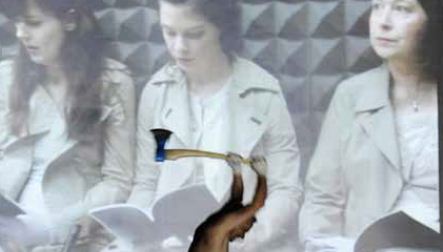
24/01/2014, by CLAS
Postdramatic Theatre and the Political
Postdramatic Theatre and the Political – International Perspectives on Contemporary Performance is an exciting new collection of essays, edited by Dr Jerome Carroll and Prof Steve Giles from the Department of German Studies here at Nottingham, and Dr Karen Jürs-Munby from Lancaster University, about the political claims of postdramatic theatre. The book, which has just been published by Bloomsbury, is the fruit of a conference of the same name, held at the Institute of Modern Languages Research in September 2011.
The case studies that make up the core of the chapters in this book leave barely any aspect of conventional dramatic theatre unchallenged. In several, the dedicated theatre building has long since been abandoned, with the action taking place for instance as a staged demonstration on the streets in front of the theatre, or in a Berlin hotel, or in a lecture hall, or in the site-specific location of a Gdansk shipyard, highly charged with national-cultural memory. Likewise, character is largely dispensed with, the stage (where it is still employed) peopled by vestigial figures, ‘text bearers’, characters without coherent psychological ‘interiority’, or characters who – for instance through being surrounded by a chorus – have multiple or collective identities. We also encounter ‘real’ people, who bring aspects of their real-world identity into the theatre, unadorned with fiction or character: disabled performers, as well as untrained actors who stand as witnesses and whose testimony evades and challenges ‘imposed, official history’. ‘Experts of daily life’ (Rimini Protokoll) are put on the stage, a term which includes both recognised ‘experts’ such as air traffic controllers and individuals ‘lower down’ the socio-economic scale, such as call centre staff and migrant workers. Sometimes character makes way for a focus on the body, in what might be taken as a revalorisation of the ‘material’ components of theatre, or of ‘appearance’ divorced in some way from ‘meaning’. Causal or ‘generative’ action is also often dispensed with: in some works there is no play at all, but what we have is always still ‘theatre’.
All of these ways in which the usual building blocks of theatre are dismantled also involve a thoroughgoing reconfiguration of the relationship between stage and audience, predominantly in ways that aim at generating audience participation or involvement. This participation can happen indirectly, for instance by being confronted with thoroughgoing indeterminacy of meaning of what happens or what is said on stage, or directly, when for instance the audience members are given the task of reading out sections of text. These are the kinds of approaches to theatre that have been called ‘postdramatic’.
Rather than simply dispensing with one or more of the components of stage, character, and action/plot, postdramatic theatre thereby also absolves itself of the traditional (at least during the eighteenth and nineteenth centuries, though key aspects go back to Aristotle) requirement or expectation that the stage should generate what Elinor Fuchs calls ‘a fictional world that aligns all dramaturgical elements into a synthetic whole’. And indeed the guiding thread in this discussion of the concepts surrounding the practice of postdramatic theatre is that, at a certain level, issues to do with postdramatic theatre and performance might usefully be cast in terms of the concern among directors and practitioners to break out of the straightjacket of re-presentation, which is to say, of the obligation to reproduce an already written story, even a series of historical events, and beyond that a ‘fictive cosmos’ that is governed by pre-ordained conventions – perhaps even ‘laws’ – of psychological motivation, causal connection, and coherent conceptual meaning more generally.
Offering analyses of a wide range of international performance examples, the chapters in this book discuss crucial aspects of the issues raised by the postdramatic turn in theatre in the late twentieth and early twenty-first century: the status of the audience and modes of spectatorship in postdramatic theatre; the political claims of postdramatic theatre; postdramatic theatre’s ongoing relationship with the dramatic tradition; questions of representation and the real in theatre; the role of bodies, perception, appearance and theatricality in postdramatic theatre; as well as subjectivity and agency in postdramatic theatre, dance and performance.
Jerome Carroll, Department of German Studies
No comments yet, fill out a comment to be the first

Leave a Reply